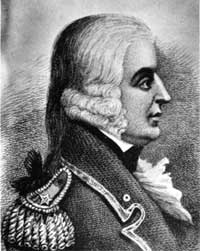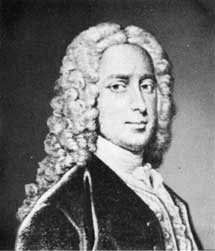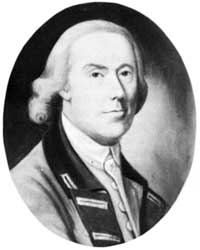|
FORT NECESSITY National Battlefield |
 |
 Maj. Gen. Edward Braddock commander of the second expedition against Fort Duquesne. |
 Sir Peter Halkett. From Parkman, Montcalm and Wolfe |
The Braddock Expedition (continued)
THE ADVANCE OF BRADDOCK'S FORCE. Braddock had arrived at Hampton Roads on February 19 and held a conference with Governor Dinwiddie at Williamsburg concerning the attitude of many of the colonies toward the proposed expedition. Concerned largely during the early spring in negotiations at Williamsburg and Alexandria for detachments of colonial militia and in assembling wagons and horses, he finally arrived at Wills Creek on May 10. During the winter of 1754—55, the trading fort at this place had been transformed into a military establishment named Fort Mt. Pleasant and renamed Fort Cumberland. Here, soon after his arrival, Braddock assembled an army of 2,150 men, a unit of artillery, 500 baggage horses, and 150 Pennsylvania wagons provided through the efforts of Benjamin Franklin. Included in the army were contingents of Colonial troops from Virginia, New York, South Carolina, and Maryland. A company of North Carolina men was on the march to join Braddock. Anticipating the difficulties which would be found in crossing rivers, Braddock had obtained from the British Admiral Keppel a force of 30 sailors to devise means of transporting the army.
By the end of the first week of June, the army was well on its march from Fort Cumberland. Scouts out in front and on the flanks guarded against a surprise attack, while axmen cleared the road to a width of 12 feet for the artillery and baggage wagons. The road-building party consisted of Poulson's Virginia carpenters who, under direction of the engineers, cut trees, built bridges, and performed general duties.
 Lt. Col. Thomas Gage, commander of the advance unit of Braddock's Army. Courtesy The Commonwealth of Massachusetts. |
Braddock's advance to Little Meadows was slow. Here, on the advice of Washington, he decided to select 1,300 men and to push forward rapidly. Colonel Dunbar, with the remaining 850 men, the heavy baggage, stores, and the artillery was to advance by slower marches. Two 6-pounders, four 12-pounders, four 8-inch howitzers, and three Coehorn mortars were attached to the leading unit. To cross the mountains each howitzer required a 9-horse team and each 12-pounder cannon, a 7-horse team. The convoy consisted of 30 wagons. Rations for 30 days were carried by 400 pack horses, and 100 spare horses accompanied the column. As part of the food supply the expedition brought with it a large herd of cattle. On June 18, with everything in readiness, 400 men, under the command of Lt. Col. Thomas Gage, moved forward with axes to blaze the way.
The advance detachment thus was decreased by nearly one-half and the extent of the carriages, on the march from Little Meadows, "was very seldom above half a mile . . . and encampments [were] but three hundred yards from the front to the rear. . . ." When the column encamped, it included Gage's advance party, the whole encampment being encircled by a chain of sentries. A member of the expedition noted that on June 25, "we passed the Great Meadows, and encamped about two miles on the other side . . . about a quarter of a mile from this camp, we were obliged to let our carriages down a hill with tackles, which made it later than usual before we got to our ground." Soon Chestnut Ridge, the last great obstacle, was passed, and the army, observing every precaution, pushed on toward Fort Duquesne. As the force approached Turtle Creek on July 8, the commanding officer was unusually apprehensive of danger from hills on his flank and placed strong detachments on these eminences to protect the flanks of the army. On the fateful next day, July 9, Braddock moved forward cautiously.

|
|
Last Modified: Mon, Dec 2 2002 10:00:00 am PDT |


